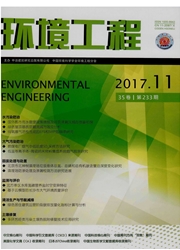

 中文摘要:
中文摘要:
于2009年11月26日至12月20日在南京北郊昼夜分粒径采集大气PM10样品,运用离子色谱法分析其水溶性无机离子的浓度及谱分布特征,讨论无机离子与大气污染物之间的关系,研究其来源特征。结果表明:PM2.1日均值为0.3921 mg/m^3,超过EPA大气质量标准(0.065 mg/m^3)5倍,PM10日均值为1.0103 mg/m^3,为国家大气PM10三级标准(0.25 mg/m^3)3.04倍,PM2.1占PM10约40%,说明冬季南京北郊颗粒物污染较严重,且以细粒子为主;PM10和PM2.1中的主要无机离子均为SO4^2-、Ca^2+、Cl-,浓度大小为SO4^2-〉Ca^2+〉Cl-,且均表现为白天浓度高于夜晚;粒径谱分布为Ca^2+、Cl-、SO4^2-均呈双峰,Ca^2+主要存在于粗粒子中,SO4^2-、Cl-主要分布在积聚模;相关性分析表明,SO4^2-与NO3和Cl-显著性相关,系数分别为0.7910、0.9123,其可能存在同源性;由NO3-/SO4^2-的特征比值,白天和夜晚分别为0.0582和0.0484,均远小于1,说明南京北郊大气污染以固定源为主。
 英文摘要:
英文摘要:
The atmospheric PM10 samples were collected day and December, 2009 according to the aerodynamic diameter, analyzing night in Nanjing northern suburb from 26 November to 20 distribution characteristics of concentration and spectrum of water-soluble inorganic ions via ion chromatography, discussing the relationship between inorganic ions and air polluters and researching sources of them. The results show that the daily mean value of PM2.1 is 0. 39 mg/m^3 which is five times more than EPA air quality criteria (0. 065 mg/m^3) and that of PM10 is 1.01 mg/m^3 which is 3.04 times of PM10 national standards of grade Ⅲ. PM2.1 occupies about 40% in PM10, that is to say PM pollution is more serious in Nanjing northern suburb in winter and fine particles account for the main part. The major inorganic ions in PM10 and PM2.1 both are SO4^2-, Ca^2+, C1- and the concentration magnitude of them is SO4^2- 〉 Ca^2+ 〉 C1-. Most of them display that the concentration during the daytime is higher than that at night. The particle diameter spectrum distribution of Ca^2+ , C1- and SO4^2- presents the double peak trends. Ca^2+ principally exist in coarse particles and SO4^2 - and C1 - mainly distribute in the accumulation model. The analysis of correlation shows that there is significant correlation between SO4^2- and NO3 - , C1- and the coefficient of them are respectively 0. 7910, 0. 9123. Maybe they have the homology. The character ration of NO3 -/SO4^2- which are respectively 0. 0582 during the daytime and 0. 0484 at night illustrates that stationary sources dominate in air pollution in Nanjing northern suburb.
 同期刊论文项目
同期刊论文项目
 同项目期刊论文
同项目期刊论文
 期刊信息
期刊信息
